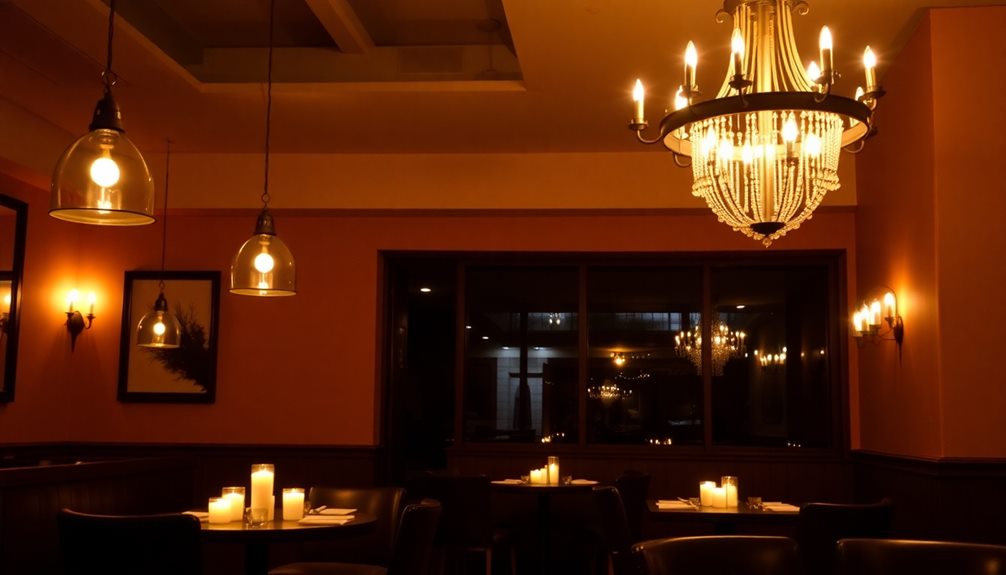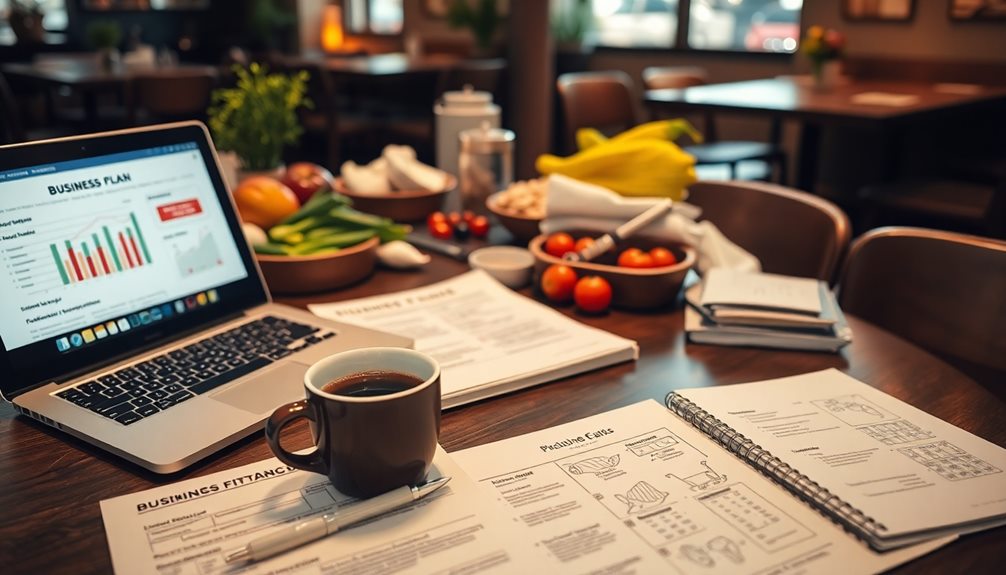When selecting the best lighting options for your restaurant, aim for a mix of ambient, task, and accent lighting. Ambient lighting sets a comfortable environment, while task lighting helps with reading menus and food preparation. Accent lighting highlights decor and architectural features, adding character. Consider using smart solutions like dimmable fixtures and occupancy sensors to enhance energy efficiency. Also, adjust your lighting based on the time of day to create the perfect atmosphere—bright for breakfast and soft for dinner. Discover more ways to elevate your restaurant's ambiance and enhance the guest experience.
Key Takeaways
- Combine ambient, task, and accent lighting for a layered and dynamic dining experience that enhances comfort and mood.
- Utilize smart lighting solutions like occupancy and daylight sensors to optimize energy use and create a customized ambiance.
- Adjust lighting throughout the day; bright lighting for breakfast and moderate to dim lighting for dinner enhances the dining atmosphere.
- Choose warm white light (2700K-3000K) to create a cozy environment, while cooler temperatures (4000K-5000K) can energize diners during lunch.
- Incorporate various fixtures such as pendant lights, chandeliers, and wall sconces to add visual interest and highlight key features of your restaurant.
Types of Restaurant Lighting
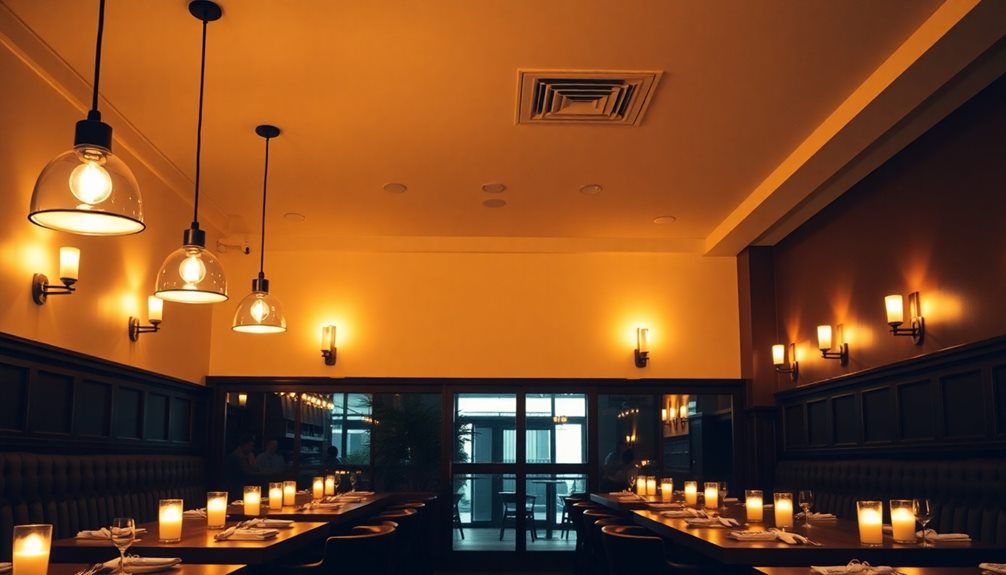
When you're designing the lighting for your restaurant, understanding the different types of lighting is vital to creating the right atmosphere.
You’ll want to start with ambient lighting, the main source of illumination that sets a comfortable and inviting environment for your guests. This type of lighting is critical for enhancing the overall dining experience. To achieve the perfect ambiance, consider using soft, warm lights that can be adjusted to match the mood of the occasion. Incorporating decorative elements like dimmable fixtures or strategically placed candles can create a cozy atmosphere that encourages relaxation and conversation. Furthermore, if you’re looking to expand your hosting options, explore some outdoor dining space design ideas that seamlessly blend natural elements with your lighting choices, creating an enchanting experience under the stars.
Next, consider task lighting, which focuses on specific areas like reading menus or food preparation. It guarantees functionality in both dining and service areas, allowing your staff and customers to navigate easily.
Accent lighting adds depth and personality to your restaurant interior by highlighting artwork or architectural features, creating visual interest.
Don't forget about natural lighting! Utilizing sunlight can enhance your ambiance while reducing energy costs, promoting a healthy dining environment.
Additionally, decorative lighting, such as unique chandeliers or pendant lights, serves as a focal point, enhancing your restaurant's aesthetic appeal.
Incorporating LED lights can provide energy efficiency and versatility across these lighting types.
Lighting Design Considerations
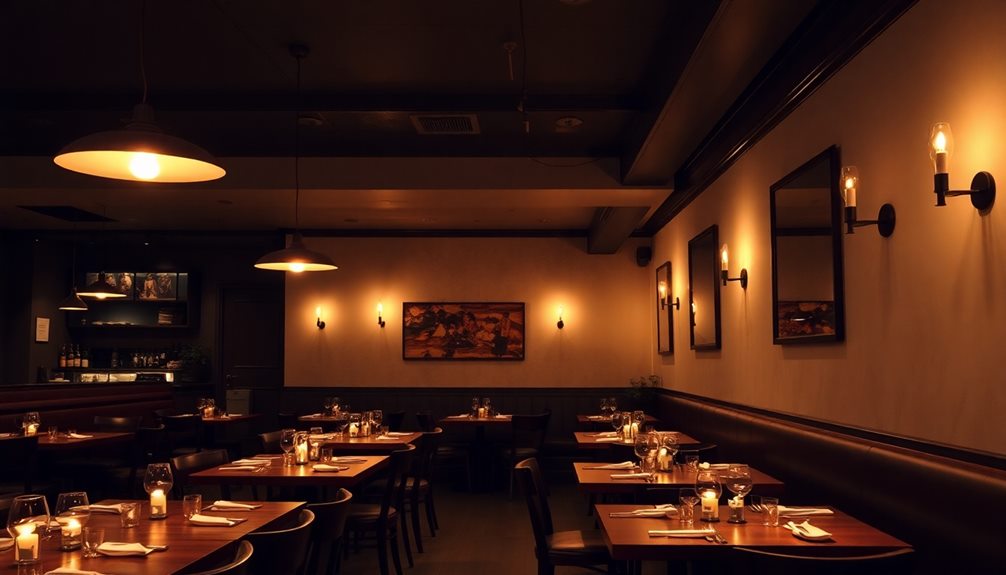
Effective lighting design is essential for creating an inviting atmosphere in your restaurant, as it directly influences diners' sensory experiences. The selection of lighting types, including ambient, task, and accent lighting, plays a significant role in shaping the customer experience. Ambient lighting sets the overall mood, while task lighting aids specific activities like reading menus or eating. Accent lighting highlights design features, adding depth and visual interest.
Consider adjusting your lighting based on the time of day. Bright lighting can stimulate alertness during breakfast, while dim lighting creates a relaxed atmosphere for dinner. Layering different lighting types not only enhances the dining experience but also adds a dynamic element to your space.
Seasonal adjustments are another key factor; adapting your lighting throughout the year can boost ambiance and comfort. Incorporating smart lighting solutions, like dimming controls and occupancy sensors, can optimize energy efficiency without sacrificing atmosphere.
Smart Lighting Solutions
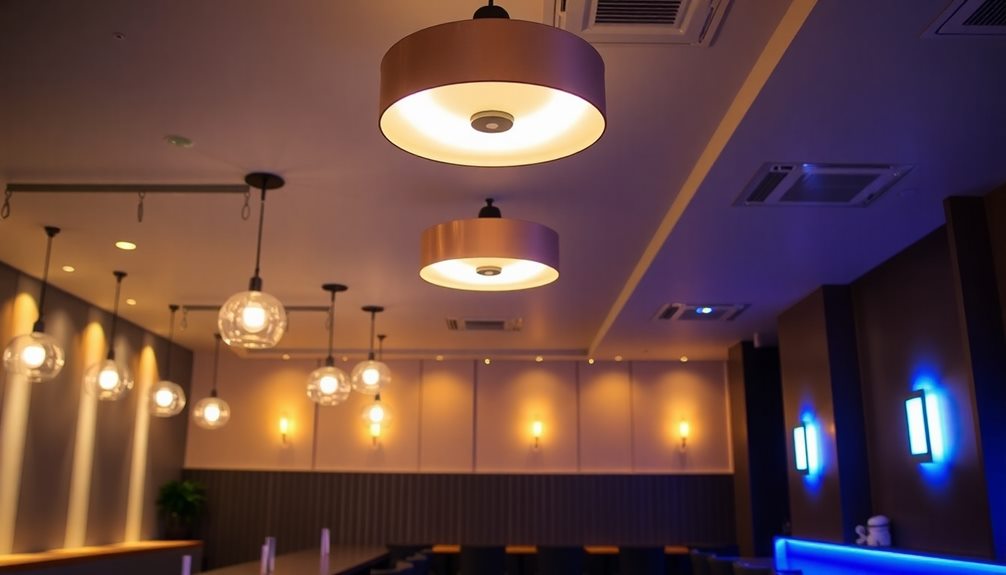
Smart lighting solutions offer you enhanced control over your restaurant's ambiance while boosting energy efficiency.
With features like occupancy and daylight sensors, you can automatically adjust lighting based on real-time needs, saving on costs.
Plus, integrating these systems with your existing technology allows for seamless management, ensuring a comfortable experience for your guests.
Energy Efficiency Benefits
Harnessing the power of smart lighting solutions can drastically improve energy efficiency in restaurants. By switching to LED fixtures with dimming capabilities, you can reduce energy consumption by up to 75% compared to traditional incandescent lights. This not only lowers operational costs but also aligns with sustainable practices.
Integrating occupancy sensors guarantees that lighting adjusts based on the presence of diners, potentially saving you 30% or more on lighting bills in unoccupied areas. Daylight sensors further enhance efficiency by detecting natural light levels, optimizing your use of artificial lighting throughout the day.
Additionally, automated scheduling allows you to manage energy use during peak and off-peak hours effectively. This means you can minimize waste while maintaining a welcoming atmosphere.
Implementing these smart lighting solutions also extends the lifespan of your fixtures, as reduced frequency of use leads to lower maintenance costs and less frequent replacements.
Ultimately, adopting these strategies not only contributes to significant energy savings but also reinforces your commitment to sustainable operations, making your restaurant an eco-friendly choice for patrons.
Enhanced Control Features
With energy efficiency firmly established, the focus shifts to how enhanced control features in smart lighting solutions can elevate the dining experience. Smart lighting allows you to adjust ambient lighting effortlessly, catering to the mood and time of day. With precise dimming control, you can create an inviting atmosphere that resonates with your diners.
Occupancy sensors enhance energy efficiency by automatically adjusting light levels when guests enter or exit your restaurant. This not only reduces operational costs but also guarantees a welcoming environment. You can further streamline operations using lighting schedules programmed through timelocks, assuring ideal lighting during peak hours while conserving energy during quieter times.
Daylight sensors also play an essential role, automatically modulating artificial lighting based on the availability of natural light. This feature helps maintain a consistent ambiance throughout the day, allowing your diners to enjoy a pleasant dining experience.
Moreover, many smart lighting solutions offer customization options, integrating seamlessly with existing restaurant technologies. This enables you to control and tailor the dining atmosphere from a single platform or remotely, making certain that your restaurant remains adaptive and responsive to your guests' needs.
Integration With Technologies
Integrating advanced lighting solutions into your restaurant's operations can transform the way you manage ambiance and energy usage.
With smart lighting systems, you can achieve a multitude of benefits that enhance both customer experience and operational efficiency.
- Automated adjustments based on occupancy optimize energy efficiency.
- Daylight sensors help maintain a comfortable ambiance by adjusting lighting according to natural light.
- Dim lighting controls enable you to create varied atmospheres throughout the day.
- Timelocks automate lighting schedules, ensuring consistency without manual intervention.
- Remote control capabilities allow restaurant managers to make quick changes from anywhere.
Specific Lighting Fixtures
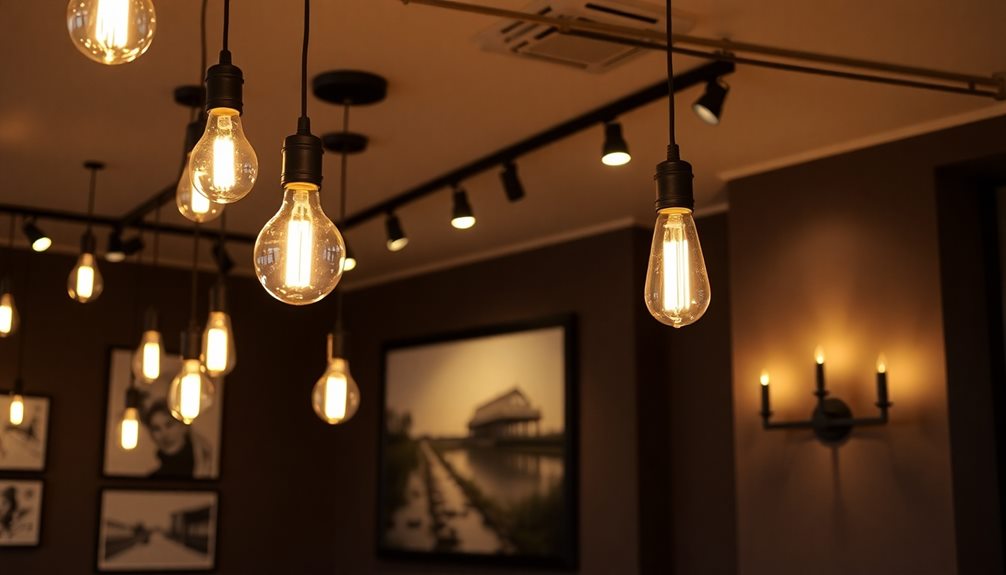
What lighting fixtures can truly transform your restaurant's atmosphere? Start with pendant lights; they provide focused illumination and come in various designs, perfect for accentuating dining tables or bar areas while enhancing your overall restaurant decor.
If you're aiming for elegance, consider chandeliers. These stunning fixtures serve as centerpieces in fine dining settings, featuring multiple light sources that elevate your restaurant's ambiance.
For versatility, wall sconces are a great choice. They offer both general and accent lighting, ideal for illuminating hallways or highlighting artwork without taking up floor space.
Recessed lighting is another excellent option—installed directly into ceilings, it creates a sleek, minimalist look and pairs well with energy-efficient LED bulbs.
Lastly, track lighting gives you flexibility. With adjustable fixtures, you can achieve targeted illumination of specific areas or design features, making it perfect for dynamic lighting arrangements in modern restaurant designs.
Lighting for Different Times
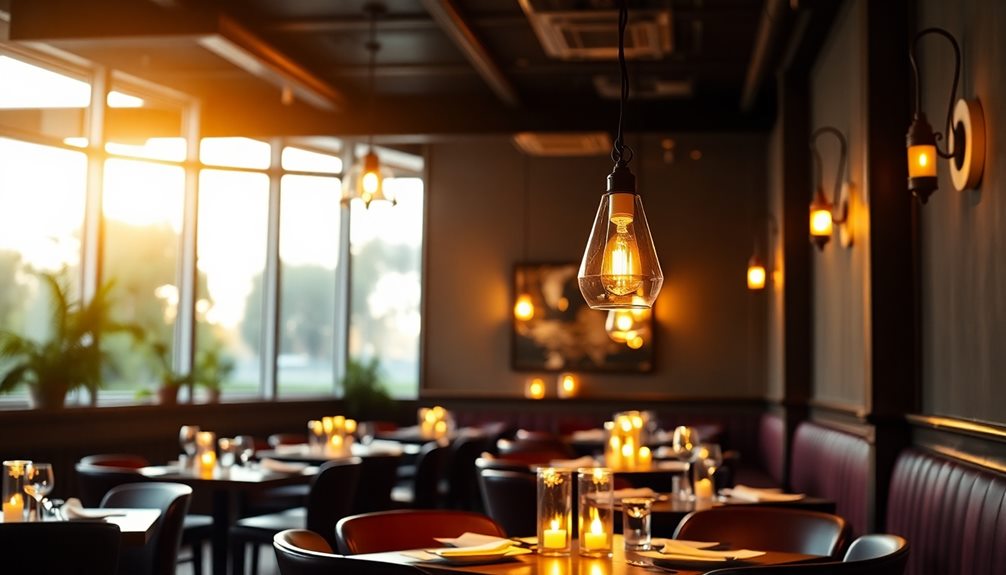
To create an enchanting dining experience, it's important to contemplate how lighting needs change throughout the day.
The right lighting can greatly enhance your customer experience, making it essential to adjust your approach for breakfast, lunch, and dinner.
- Breakfast: Implement bright lighting to energize diners and help them read menus easily.
- Lunch: Use moderate lighting levels to create a balanced atmosphere that encourages quick turnover.
- Dinner: Shift to dimming techniques for a relaxed, cozy atmosphere that invites guests to linger.
- Natural Light: Leverage seasonal variations in daylight to enhance your ambient lighting throughout the year.
- Task Lighting: Consider incorporating task lighting for specific areas, ensuring functionality without compromising the overall vibe.
Importance of Restaurant Lighting
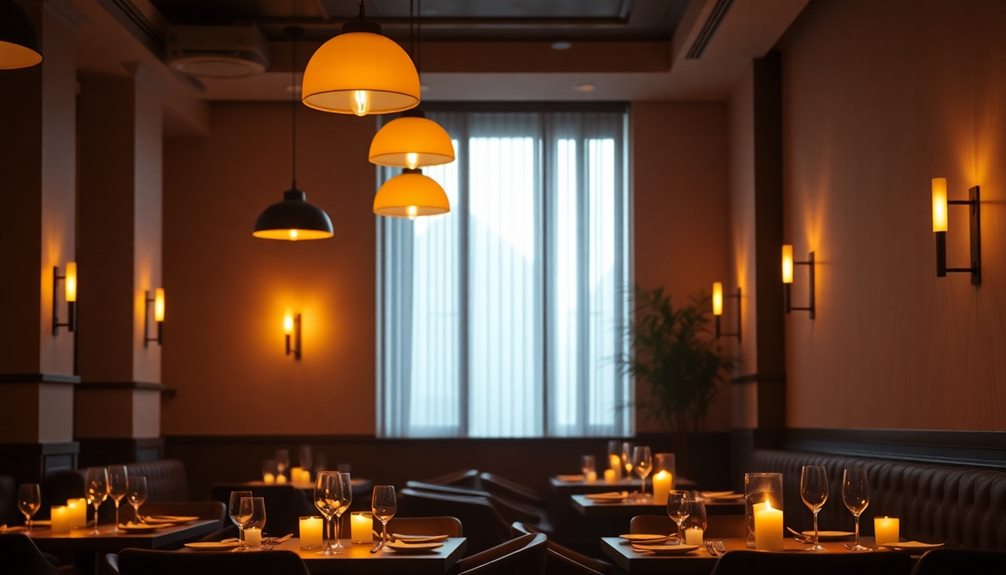
When considering the overall dining experience, restaurant lighting plays a pivotal role in shaping customer perceptions and decisions. Studies show that 91% of customers factor in lighting when choosing where to dine, highlighting its importance. A well-designed lighting scheme enhances customer comfort and mood, encouraging longer stays and increased spending.
Using a combination of ambient, task, and accent lighting can greatly impact consumer perception and food taste. Ambient lighting sets the overall tone, while task lighting guarantees functionality, especially in areas like the bar or kitchen. Accent lighting draws attention to specific features, creating a visually appealing environment.
Moreover, innovative lighting solutions, such as smart lighting systems, offer energy efficiency while allowing you to tailor ambiance for different times of the day. This adaptability not only enhances customer satisfaction but also aligns with the restaurant's concept, creating a cohesive narrative throughout the space.
Ultimately, effective restaurant lighting influences not just the emotional and psychological responses of your guests but also their overall satisfaction. Prioritizing the right lighting can transform your establishment into a memorable dining destination.
Setting the Mood
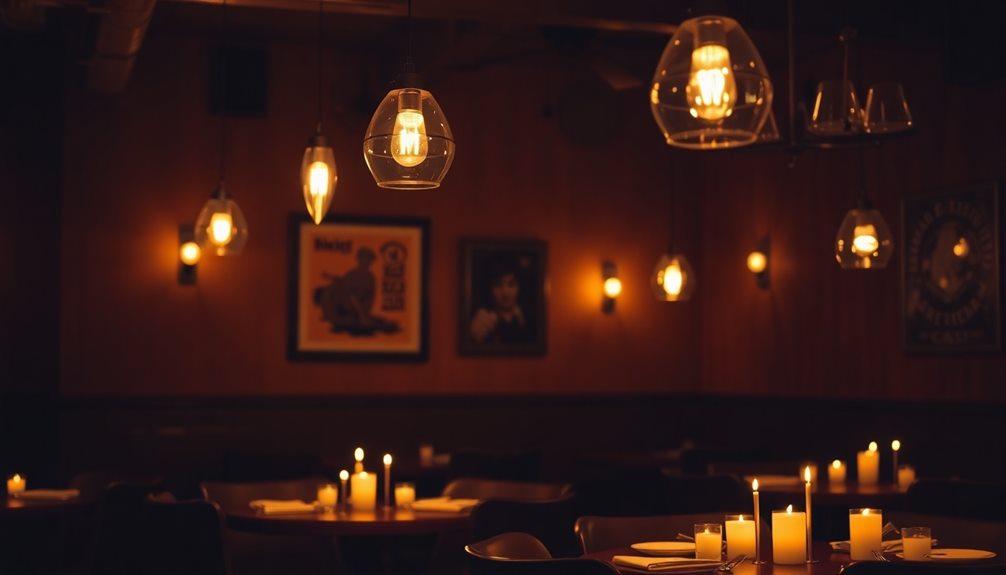
When you think about setting the mood in your restaurant, consider how lighting shapes the atmosphere.
Warmer color temperatures and dimmed lights create a cozy vibe that invites guests to relax and enjoy their meals.
Lighting and Atmosphere
Lighting greatly influences the atmosphere of a restaurant, with studies showing that 91% of customers view ambiance as an important factor in their dining choices.
You want to create an inviting atmosphere that encourages your diners to relax and enjoy their meals. Incorporating unique coffee gear and accessories can further enhance the dining experience, as they can add charm and character to the overall aesthetic.
Here are some vital elements to take into account:
- Warmer hues foster relaxation and intimacy, making diners linger longer.
- Layering various types of lighting—ambient, task, and accent—adds depth to the dining experience.
- Task lighting fixtures guarantee that menus are readable and food is well-lit, enhancing the overall customer experience.
- Accent or ambient lighting can highlight architectural features or décor, boosting the restaurant's visual appeal.
- Seasonal adjustments to your lighting can keep the atmosphere fresh and engaging throughout the year.
Color Temperature Influence
Color temperature plays an essential role in setting the mood within your restaurant. By understanding how warm white light (2700K-3000K) and cool white light (4000K-5000K) affect customer behavior, you can strategically design your lighting to enhance the dining experience. Warm light creates an inviting atmosphere that encourages longer stays and higher spending, while cooler light promotes alertness—ideal for fast-paced environments.
Here's a breakdown of the effects of different color temperatures:
| Light Type | Impact on Dining Experience |
|---|---|
| Warm White Light | Creates a cozy, inviting atmosphere; enhances food appeal |
| Cool White Light | Promotes energy and alertness; suitable for quick dining |
The strategic use of color temperature in your lighting design can align with your brand identity, adapting throughout the day. Brighter lights for breakfast and lunch can energize your guests, while shifting to warmer lights for dinner can create a more intimate setting. This thoughtful approach not only enhances customer satisfaction but also fosters a memorable dining experience that keeps patrons coming back.
Dimming for Ambiance
Adjusting the brightness of your restaurant's lights can transform the dining experience, setting the perfect mood for every occasion.
Dimming controls allow you to tailor lighting levels throughout the day, creating a relaxed atmosphere during dinner service while maintaining brightness for breakfast and lunch.
Here's how you can enhance your space:
- Encourage lingering: Lower lighting levels invite diners to stay longer, potentially increasing sales.
- Utilize smart dimming systems: These can automatically adjust lights based on the time of day or occupancy, improving energy efficiency.
- Opt for dimmable LED fixtures: They provide versatility, allowing you to shift between various dining moods effortlessly.
- Highlight architectural features: A well-planned dimming strategy can accentuate artwork or design elements, adding visual interest.
- Create memorable experiences: Adjusting the ambiance can enhance customer satisfaction and encourage repeat visits.
Frequently Asked Questions
What Type of Lighting Is Best for a Restaurant?
When choosing lighting for your restaurant, consider a mix of ambient, task, and accent lighting. It creates an inviting atmosphere, enhances safety, and highlights unique features, ensuring your space feels warm and welcoming for diners.
How to Properly Light a Restaurant?
To properly light a restaurant, you'll want to mix ambient, task, and accent lighting. Use warm colors, smart controls, and natural light, adjusting fixtures seasonally to create a welcoming and efficient dining atmosphere.
What Is the Best Lighting for Food Display?
Fabulous food deserves fantastic lighting! You should choose LED lights with a high CRI, incorporate accent fixtures to spotlight dishes, and consider dimmable options to create the perfect atmosphere for your delectable displays.
Why Do Fancy Restaurants Have Dim Lighting?
Fancy restaurants use dim lighting to create intimacy, making you feel relaxed and encouraging you to linger. It enhances food appeal, reduces noise, and camouflages decor imperfections, contributing to a more enjoyable dining experience.
Conclusion
As you wrap up your lighting choices, think of your restaurant as a stage, where every bulb plays a role in the performance. Just like a spotlight enhances a leading actor, the right lighting can elevate your dining experience and keep customers coming back. Research shows that 70% of diners appreciate ambiance, proving that a well-lit space isn't just about visibility; it's about creating a memorable experience. Shine bright, and let your restaurant tell its story!
